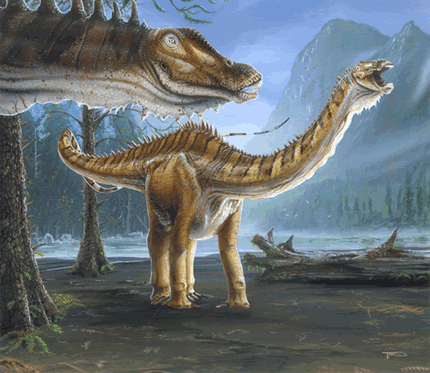Diplodocus longus
Homepage > Dinosaur List D - Diplodocus
longus
Dinosaur Lists by Letter A B
C D
E F
G H
I J
K L
M N
O P
Q R
S T
U V
W X
Y Z
(dip-lod-oh-cuss)
"double beam"
Describer Marsh, 1878
Also Known As Seismosaurus Gillette, 1991
Type of Species
Order Saurischia
SubOrder Sauropodomorpha
InfraOrder Sauropoda
Micro-Order --
Family Diplodocidae
Size 88 feet (27 meters) long
Period Late Jurassic, 150 million years ago
Fossilsite Colorado, Wyoming, USA
Diet Herbivore
Species
Diplodocus longus Marsh, 1878
Diplodocus carnegii Hatcher, 1901
Diplodocus hayi Holland, 1924
Diplodocus hallorum (Gillette, 1991) Lucas 2004

Image courtesy of Todd Marashall
Diplodocus is on of the longest land animals that has ever lived on Earth.
Diplodocus lived during the Late Jurassic, about 150 million years ago.
It grew up to 88 feet in length and weighed about 12 tons. This large
herbivore must have needed to consume vast amounts of vegetation every
day to survive. Diplodocus had peglike teeth in the front of its jaws.
There were no teeth in the back of its mouth, these teeth were able to
strip conifers, gingkoes, ferns, cycads, and horse-tails. Diplodocus had
a long neck that stretched from its body for about 26 feet. It had no
problems reaching the vegetation on these tall trees. Once this vegetation
was inside its stomach, gastroliths (stomach stones) rolled around and
knocked against the food, crushing it to a pulp and making in easier to
digest.
Diplodocus may have lived in herds, always in search of new places to feed from. This animals were like vacuums going around and striping vegetation from all around them. They must have traveled for long distances to get the food they needed. Diplodocus hindlegs were longer than the front legs. There were five toes on each foot, and the first three toes had claws. Its long tail was 45 feet long. There were between 70-80 vertebrae in it. Diplodocus may have used its tail when he needed to defend itself from other predators. In the past it was believed that Diplodocus dragged its tail, but since no drag marks have been found alongside its fossilized footprints, it is now believed that the tail was held high off the ground.
Fact
Diplodocus was the most famous dinosaur on display around the world in
museums in London, Paris, Berlin, Vienna, St Petersburg, Mexico City,
La Plata (Argentina) and Munich. Its title was stripped once Tyrannosaurus
was discovered.
Discovery
Diplodocus was first discovered back in 1877 in Colorado, by a fossil
hunter Samuel Williston. This find was not complete, but it had enough
fossilized bones to identify that it was a new dinosaur. Diplodocus name
was given by an American paleontologist Othniel Marsh in 1878. Diplodocus
means "double beam" because of some of its tail bones reminded
him of the shape of a beam. In 1899, a complete skeleton was found in
Wyoming, since then Diplodocus has become one of the best known dinosaur.